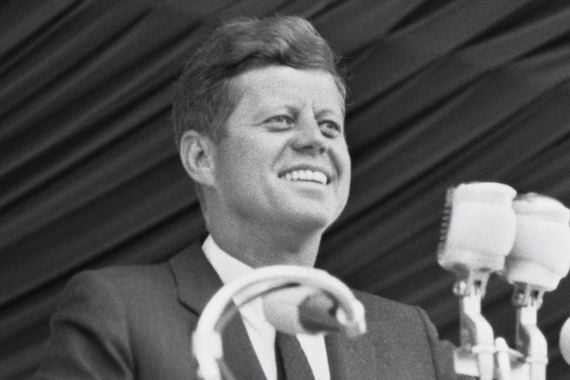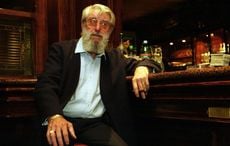The young president understood the Irish language inscription on one of the battlefield monuments.
* This is the epilogue to Niall O'Dowd's book "Lincoln and the Irish: The Untold Story of How the Irish Helped Abraham Lincoln Save the Union" available on Amazon.
John F. Kennedy was fond of invoking Republican Abe Lincoln in his speeches. To those who disagreed with his Lincoln homages, he said, “Some may say that a Democratic candidate for the Presidency has no right to invoke the name of Lincoln. I disagree. Abraham Lincoln belongs to the ages, and he belongs to all Americans, regardless of their party.”
Kennedy undertook a pilgrimage to Gettysburg as president to pay such a homage. On Saturday, March 31, 1963, Kennedy, dressed in a blue jacket and driving a white Mercury convertible with the top down, headed a five-car convoy, which included four Secret Service cars, from Camp David to the Gettysburg battlefield, a distance of 26.2 miles.
It had been almost one hundred years since Lincoln’s Gettysburg Address, and Kennedy doubtless felt he could be back again in November to deliver a speech marking that momentous anniversary.
Accompanying him was his wife Jackie and oldest child Caroline, both of whom sat in the front seat. In the back was Red Fay, his Undersecretary of the Navy, but more importantly, a reliable Kennedy sidekick and later author of a fawning memoir about Kennedy called The Pleasure of His Company.
Fay later recounted the visit. Along the way, they picked up local high school teacher and Gettysburg expert Jacob Sheads, who met the presidential party in a parking lot near the site of the battle and was astonished to find the president behind the wheel of his own car.
There may not have been much need for Sheads, as Fay recalled. “The knowledge the president displayed about the Civil War amazed me. When we came to a certain area where a Boston or Massachusetts unit had fought, he recounted the battle with such detail I could almost see it taking place. I kept expecting a Kelly or a Murphy to come charging up the gorge.”
We’re speaking to IrishCentral founder Niall O’Dowd about his new book on Lincoln and the Irish.
Posted by IrishCentral.com on Déardaoin, 8 Márta 2018
Sheads thought his well-planned itinerary would please the president, but JFK had other ideas, displaying his knowledge of the battlefield in such a manner that it drew Sheads’s admiration.
After visits to several landmarks, Kennedy then drove to Rose’s Wheatfield, through which the Irish Brigade had charged on July 2, 1863, suffering grievous losses. The monument to the Irish Brigade is on top of the Stony Hill/Loop area of the battlefield. Nearby is a monument to the Massachusetts 28th, an all-Irish regiment. On top of the monument is inscribed the Fenian battle cry “Faugh a Ballagh.” The guide asked Kennedy if he understood the words; Kennedy answered instantly, “Clear the Way.” Sheads realized that this was a man who knew his Irish American history.

Love Irish history? Share your favorite stories with other history buffs in the IrishCentral History Facebook group.
There is even video of Kennedy, taken by Deborah Deitsch Mason, a relative of Sheads’. In it, Jack and Jackie are close together in the front seat, and he is pointing out landmarks. Poignantly, they are near the Eternal Light Peace Memorial. Sheads would later say that Jackie Kennedy got the idea for the eternal flame over her husband's grave from the Eternal Light Peace Memorial at Gettysburg.
Lincoln and Kennedy had many similarities. Both were avatars of a new age, both magnificent orators and inspirational examples for their fellow citizens. Both took on the battle for the rights of the widely despised black Americans. Both would die at the zenith of their careers from an assassin’s bullet.
JFK even cribbed a few words from Lincoln in his inauguration on January 20th 1960:
“In your hands, my dissatisfied fellow-countrymen, and not in mine, is the momentous issue of civil war.” [From Abraham Lincoln’s first inaugural address, March 4, 1861]
“In your hands, my fellow citizens, more than mine, will rest the final success or failure of our course.” [From John F. Kennedy’s inaugural address]
On that March day in 1963, their paths also crossed, the Irish American descendant of Famine emigrants and the country lawyer from Springfield. They both owed a great debt to the Irish: Kennedy, for helping elect him by voting in massive numbers, and Lincoln, for their role in helping him win the Civil War. Lincoln, although initially thinking of the Irish as foes of the Democratic Party, embraced them in the end as they embraced him, despite their fears of his alleged links to the nativist Know-Nothings.
As for Kennedy, the Irish in the Civil War entranced him. Before the president’s visit to Ireland in June 1963, Letitia Baldrige Hollensteiner, the White House Social Secretary, remembers how determined Kennedy was to remind his ancestral countrymen of the importance of that involvement. She later wrote:
"I once found an old flag, an Irish Brigade flag which had been used during the Civil War by the Irish Brigade here in this country. He liked that very much, and we got it to give to the President of Ireland. He and Mrs. Kennedy spent a great deal of time deciding how it should be presented; how it should be framed, encased in glass, what the plaque should say. The President, being such an historian, insisted that the plaque tell the whole story of the flag. He made me check and recheck, and he said, ‘That sounds fishy. Something’s wrong with your facts. Get your facts straight.’
There was one more moment of communion between the two most charismatic presidents. After JFK’s assassination, Jackie Kennedy immediately decreed that Lincoln's funeral be the lodestar for her husband’s obsequies.
Historians quickly studied how the White House had been enveloped in black in mourning for Lincoln, and the order of the funeral, such as who marched where and when, was also studied. One last-minute request Jackie made was for an eternal flame beside the grave. She said she wanted to light a flame at the climax of the service in Arlington that would burn forever in memory of her husband.
She remembered the day when she and the president had visited Gettysburg. There, at the Eternal Light Peace Memorial, dedicated in 1938, she had seen an eternal flame. A similar one was built in Arlington over his freshly-dug grave in time for Jackie to light it on Monday afternoon. A final connection was made between two tragic presidents one who had dared to dream and another to fight for the dream of democracy when it came to it.
* This is the epilogue to Niall O'Dowd's new book "Lincoln and the Irish: The Untold Story of How the Irish Helped Abraham Lincoln Save the Union" available on Amazon.
*Originally published in 2018. Updated in July 2023.
Here Niall O'Dowd talks about his book with Frances Mulraney:
We’re speaking to IrishCentral founder Niall O’Dowd about his new book on Lincoln and the Irish.
Posted by IrishCentral.com on Thursday, 8 March 2018




Comments